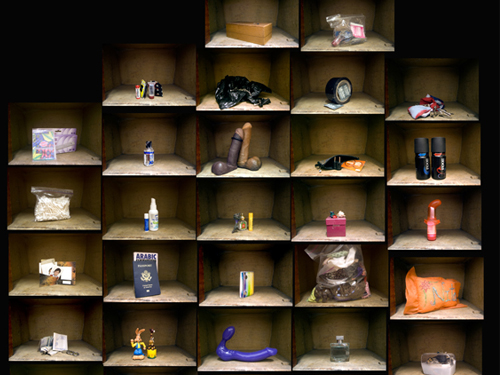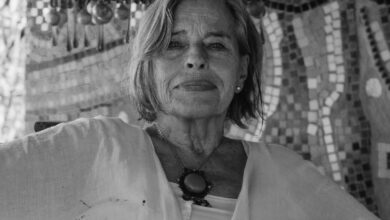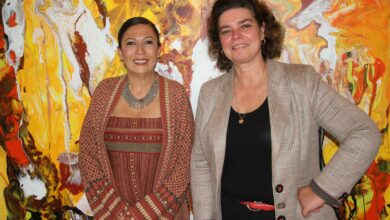
In large part, our lives consist of objects: things we use, arrange, store, consume, and transport from place to place. Some of these objects we treasure, others we use without considering their value, and others we indifferently discard.
The artist Amanda Kerdahi Matt has made it her practice to investigate everyday objects and our relationships to them. For Kerdahi Matt, the scraps stuffed in our wallets, the articles unwittingly collected on our nightstands, and the dusty piles on our forgotten shelves are material full of potential and meaning. In the domestic space that also functions as her artist studio, she contemplates quotidian objects, believing them to be a network of artifacts that identify and define us.
"For me, the mundane is really interesting as [a] daily record of living, of a life," Kerdahi Matt tells Egypt Independent. "Documentation of that is rich. It is both incredibly personal, but at the same time, it’s so generic."
Since 2003, the artist has been making a series of works entitled “Inventories,” in which she catalogs the objects present in a particular space.
Her first work, which she says she just "stumbled upon," was a series of photo-scans of the objects in her purse. The work functions as a kind of auto-ethnography through objects, disclosing personal details at the same time that it exhibits cultural particulars. One inventory, of the artist's wallet, is particularly revelatory of her environment, with its numerous cards dedicated to specific stores. The artist says it could be called, “My American Wallet.”
She continues to make inventories on a regular basis, with the aim of one day having "maybe 50 inventories over 20 years." The inventories have taken different directions. In 2010, Kerdahi Matt performed an inventory, emptying the contents of her purse and arranging them on a table while narrating a few details about each object to her audience.
In these early works, we see the roots of a practice that later extends into deeper investigations of particular objects. In 2010, Kerdahi Matt held a solo exhibition in an apartment she had rented in Cairo, but had not yet moved into. In this private domestic space, she installed a series of explorations of halawa, the sugar wax many Egyptian women use for hair removal. Exhibition visitors were each given a spoon of halawa to suck on while viewing the rooms of the exhibition. In one, lumps of halawa stuck to, dripped from, and fell off the walls. In another, visitors could watch a video of a woman removing her body hair with the handmade substance.
Some visitors to “Halawa” questioned the significance of investigating an object so deeply embedded in the culture. The artist explains her initial interest in this ordinary object through personal experience. Growing up in the United States, she watched her Egyptian mother spend one day each month preparing and using halawa, a ritual that was “something different” from the dominant American culture. As a child, she enjoyed this day because her mother always gave her a piece of halawa to eat. As she became a young woman and began to feel pressure from her mother to use halawa to remove her body hair and “keep clean,” the object changed from a source of pleasure to one of pain. The rooms of Kerdahi Matt’s exhibition generated conversations about gender, culture, and pain, revealing the various, conflicting relationships people had to this singular object. In other words, the artist’s work ushers the object out of the realm of ordinary signifier and into the social realm, where it acquires heterogeneous meanings through articulated personal associations.
Kerdahi Matt’s work in 2011 is increasingly interested in networks, specifically the connections between everyday objects and the people who use them.
"When you name something, it becomes an object,” she says, as we talk about her work. “Let's say the space between you and I, right now, is half a meter. We can define how you and I are connected in multiple ways, but once we say how we are connected or how we communicate, we are putting a name on it, so that [the] thing in between then becomes another object… I am really interested in [this] space between things, and how that space becomes a whole other thing.”
The artist’s most recent works-in-progress are a combination of video, performance, and installation, investigating networks of objects in everyday use. The video “Approximately 374” documents an installation constructed in Kerdahi Matt’s home/studio. The eye of the camera follows a length of orange yarn to which an array of objects is connected. The yarn traverses the space, from walls to ceiling to floor, across the length and width of the room. The objects, which include jewelry, shoes, notes, a pink lock, a menstrual cup, the tape torn out of a cassette, and dozens of cigarette butts, sway along the tense length of string. In these images, there is a tension between order and disorder; we can see the mark of the artist’s hand that has decided a place for each object, though their arrangement follows no deducible logic. Of these objects, the artist says, “It’s [a] collection of things that anybody can have. It’s any action that anybody can be doing. In that way, it’s recognizable and identifiable beyond my personal experience and my personal identification through objects.”
In a long shot in “Approximately 374,” we witness the artist as she struggles through the routine ritual of rolling a cigarette. The artist herself appears as another object on the string, her hands knotted and tangled in the visual network. Watching her within this structure, the viewer is forced to question whether these objects are useful material, or whether they debilitate the person connected to them. One might imagine her breaking free from the constraints of the complex matrix, at the same time that one might question what this person would be without the objects she relates to.
“In the end, the network itself is an object,” says the artist. All of us are part of that network, and each of us has only limited control over specific portions of it. Kerdahi Matt’s work is a reminder that objects are not only things we collect and use, but that they in turn shape our environments, our relationships, and our personal and cultural identities. As ethnography of the mundane, her work enables its viewers to re-examine the oft-overlooked composition of everyday life.




